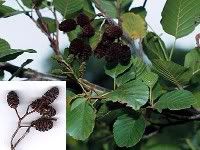

Alder (Alnus glutinosa, A. incana, A. serrulata)
Folk Names: Black Alder, Common Alder, English Alder, European Alder; A. incana American Speckled Alder, Gray Alder, A. serrulata Oregon Alder, Red Alder, Smooth Alder, Tag Alder
Description: Alder is a deciduous member of the birch family. In Europe, it grows as far north as the Arctic Circle, westward into Asia and south into northern Africa. Alders prefer cool climates, moist woods, watercourses, marshy, and rocky banks with flooded, loamy soils. The dense root system retains banks of swift waterways. The erect trunk grows from 65 to 100 ft with rough brown bark which cracks into slender, vertical scales in summer. The wood is green in the summer and brown and woody in the fall.
Alders grow from a sparse, spreading system to form a broad, conical crown. The leaves are broad and simple, obovate and irregularly toothed at the margins. Each is dark green above and lighter and sticky below and up to four inches long. In March, unisexual flowers grow in catkins. The greenish-yellow male flowers are cylindrical and pendulous, appearing before the leaves. The reddish female flower is ovoid and erect. The female becomes a small stalked strobile, producing small winged achenes when ripe wood becomes stronger in water;
Alnus serrulata resembles the typical alder tree, but has elliptic bluntly toothed leaves. The bark is blackish-gray with small, corky warts. The Red Alder grows along the Pacific Coast from Alaska to northern California.
Alnus incana likes wet conditions without stagnant water. It is highly resistant to frost. The tree grows from 33 to 65 ft, and its light gray bark is smooth and shiny. White down appears on young branches and leaf stalks. The leaves are simple, dark green and glabrous at top, whitish gray and pubescent below, on a stem with a hairy stipule. They are ovate-elliptical in shape, cordate at the base with sharply double-toothed margins. The flowers grow in catkins. The males are long and pendulous, appearing before the leaves, and the females are shorter and lack a stalk in groups of 2 to 5. The fruits are tiny achenes growing in strobiles with woody scales.
Effects:
Planet: Venus, Mars, Saturn Zodiac: Cancer, Pisces
Element: Water
Associated Deities: Calypso (Atlas' daughter), Embla (1st woman of Norse lore), Eostara, Minerva
Traditions:
The Alder is one of seven sacred trees in Celtic lore. Called Fearn, it is named for 1st month of spring, Mar 18- Apr 14, and it is the fourth letter of the Druidic tree alphabet. Crimson is sacred to the Alder, as are the fire-garnet and Saturday. It corresponds with rune is or isa.
Alder was used at the entrance of Calypso's cave on her Elysian island.
According to folklore, the wood of Alder is one of many woods used when staking a vampire.
According to Norse legend, the first woman, Embla, was fashioned from Alder wood. Then life was breathed into her by Odin.
Alder has associations to the spring equinox.
Magic:
The bark may be carried or used in protection spells. It may also be powdered in any incense mixture for the same purpose.
Alder has the ability to enhance divinatory skills.
Alder has been used in rituals of death and dying. It may be used to protect loved one who has passed and may be planted on a grave for that intent.
Known Combinations:
None Noted
Medical Indications: Parts Used : bark, leaves
Alder contains tannin, making it a serviceable astringent. Like willow and birch, it contains compounds that make it an excellent anti-inflammatory and fever reducer. The bark and leaves have been brewed as a quinine substitute.
Nutrition:
The wood has been used to smoke meats.
Mercantile Uses:
The young wood is brittle and easily worked. In Scotland, the older wood is used for making fine furniture and is called Scottish Mahogany. Alder wood is remarkably strong permanently submerged. For this reason, it is used for piles and hydraulic work. Demand often exceeds demand and birch wood is used instead. Nitrogen fixing bacteria colonize roots and enrich the soil wherever it is grown.
The bark is used by dyers, tanners, leatherworkers, and for fishermen's nets. A natural green-gray dye may be extracted from the bark. It is said the fairy folk use this dye to conceal themselves in the woodlands. With the addition of copperas, it may be used as a foundation for blacks. Bark and young shoots create a yellow dye, and with some copper, it becomes useful for half-tints and shadows of flesh on tapestries. Shoots cut in March will produce a cinnamon shade. Dried and powdered, these same shoots will make a tawny color. Fresh wood will produce a pinkish-fawn shade. On wool, alder makes a dye referred to as Aldine Red. The tannin content of the wood and leaves would make alder useful for tanning if not for the other coloring matter present. In Lapland though, it is chewed and the saliva is used to dye leather garments. Charcoal made from alder is used in the manufacture of fire works and gunpowder.
The leaves and branches contain a natural pesticide. The inner bark may be boiled in vinegar and rubbed on the body to kill lice and scabies mites. It also dries up scabs.